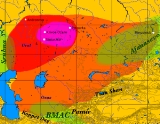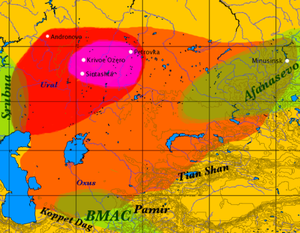
Afanasevo culture
Encyclopedia

Archaeological culture
An archaeological culture is a recurring assemblage of artifacts from a specific time and place, which are thought to constitute the material culture remains of a particular past human society. The connection between the artifacts is based on archaeologists' understanding and interpretation and...
of the late copper and early Bronze Age
Bronze Age
The Bronze Age is a period characterized by the use of copper and its alloy bronze as the chief hard materials in the manufacture of some implements and weapons. Chronologically, it stands between the Stone Age and Iron Age...
of southern Siberia
Siberia
Siberia is an extensive region constituting almost all of Northern Asia. Comprising the central and eastern portion of the Russian Federation, it was part of the Soviet Union from its beginning, as its predecessor states, the Tsardom of Russia and the Russian Empire, conquered it during the 16th...
.
This early extreme outlier of presumably Indo-European
Proto-Indo-Europeans
The Proto-Indo-Europeans were the speakers of the Proto-Indo-European language , a reconstructed prehistoric language of Eurasia.Knowledge of them comes chiefly from the linguistic reconstruction, along with material evidence from archaeology and archaeogenetics...
culture makes it an automatic candidate for being the earliest attested representative for speakers of the Tocharian stock
Tocharian languages
Tocharian or Tokharian is an extinct branch of the Indo-European language family. The name is taken from the people known to the Greeks as the Tocharians . These are sometimes identified with the Yuezhi and the Kushans. The term Tokharistan usually refers to 1st millennium Bactria, which the...
.
The burials bear a resemblance to those much further west in the Yamna culture
Yamna culture
The Yamna culture is a late copper age/early Bronze Age culture of the Southern Bug/Dniester/Ural region , dating to the 36th–23rd centuries BC...
, the Sredny Stog culture
Sredny Stog culture
The Sredny Stog culture dates from the 4500-3500 BC. It was situated just north of the Sea of Azov between the Dnieper and the Don...
, the Catacomb culture
Catacomb culture
The Catacomb culture, ca. 2800-2200 BC, refers to an early Bronze Age culture occupying essentially what is present-day Ukraine. It is seen more as a term covering several smaller related archaeological cultures....
, the Poltavka culture
Poltavka culture
Poltavka culture, 2700—2100 BC, an early to middle Bronze Age archaeological culture of the middle Volga from about where the Don-Volga canal begins up to the Samara bend, with an easterly extension north of present Kazakhstan along the Samara River valley to somewhat west of Orenburg.It is...
and the Corded Ware Culture
Corded Ware culture
The Corded Ware culture , alternatively characterized as the Battle Axe culture or Single Grave culture, is an enormous European archaeological horizon that begins in the late Neolithic , flourishes through the Copper Age and culminates in the early Bronze Age.Corded Ware culture is associated with...
. The Afanasevo culture was succeeded by the Karasuk culture
Karasuk culture
The Karasuk culture describes a group of Bronze Age societies who ranged from the Aral Sea or the Volga River to the upper Yenisei catchment, ca. 1500–800 BC, preceded by the Afanasevo culture. The remains are minimal and entirely of the mortuary variety. At least 2000 burials are known. The...
in the east.
Spread
It became known from excavations in the MinusinskMinusinsk
Minusinsk is a historic town in Krasnoyarsk Krai, Russia. It serves as the administrative center of Minusinsky District, although it is not administratively a part of it. Population: 44,500 ....
area of the Krasnoyarsk Krai
Krasnoyarsk Krai
Krasnoyarsk Krai is a federal subject of Russia . It is the second largest federal subject after the Sakha Republic, and Russia's largest krai, occupying an area of , which is 13% of the country's total territory. The administrative center of the krai is the city of Krasnoyarsk...
, southern Siberia
Siberia
Siberia is an extensive region constituting almost all of Northern Asia. Comprising the central and eastern portion of the Russian Federation, it was part of the Soviet Union from its beginning, as its predecessor states, the Tsardom of Russia and the Russian Empire, conquered it during the 16th...
, but the culture was also widespread in western Mongolia
Mongolia
Mongolia is a landlocked country in East and Central Asia. It is bordered by Russia to the north and China to the south, east and west. Although Mongolia does not share a border with Kazakhstan, its western-most point is only from Kazakhstan's eastern tip. Ulan Bator, the capital and largest...
, northern Xinjiang
Xinjiang
Xinjiang is an autonomous region of the People's Republic of China. It is the largest Chinese administrative division and spans over 1.6 million km2...
, and eastern and central Kazakhstan
Kazakhstan
Kazakhstan , officially the Republic of Kazakhstan, is a transcontinental country in Central Asia and Eastern Europe. Ranked as the ninth largest country in the world, it is also the world's largest landlocked country; its territory of is greater than Western Europe...
, with connections or extensions in Tajikistan
Tajikistan
Tajikistan , officially the Republic of Tajikistan , is a mountainous landlocked country in Central Asia. Afghanistan borders it to the south, Uzbekistan to the west, Kyrgyzstan to the north, and China to the east....
and the Aral
Aral
Aral, also known as Aralsk or Aral'sk, is a small city in south-western Kazakhstan, located in the oblast of Kyzylorda. It serves as the administrative center of Aral District. Population roughly 39,000...
area.
Economy
The economy seems to have been semi-nomadic pastoralism, with cattle, ovicaprids and horse remains being documented, along with those of wild game.Culture
The culture is mainly known from its inhumations, with the deceased buried in conic or rectangular enclosures, often in a supine position, reminiscent of the Yamna burials, but there are a number of settlements as well. Metal objects and the presence of wheeled vehicles are documented.The burials bear a remarkable resemblance to those much further west in the Yamna culture
Yamna culture
The Yamna culture is a late copper age/early Bronze Age culture of the Southern Bug/Dniester/Ural region , dating to the 36th–23rd centuries BC...
, the Sredny Stog culture
Sredny Stog culture
The Sredny Stog culture dates from the 4500-3500 BC. It was situated just north of the Sea of Azov between the Dnieper and the Don...
, the Catacomb culture
Catacomb culture
The Catacomb culture, ca. 2800-2200 BC, refers to an early Bronze Age culture occupying essentially what is present-day Ukraine. It is seen more as a term covering several smaller related archaeological cultures....
and the Poltavka culture
Poltavka culture
Poltavka culture, 2700—2100 BC, an early to middle Bronze Age archaeological culture of the middle Volga from about where the Don-Volga canal begins up to the Samara bend, with an easterly extension north of present Kazakhstan along the Samara River valley to somewhat west of Orenburg.It is...
, all of which are believed to be Indo-European
Proto-Indo-Europeans
The Proto-Indo-Europeans were the speakers of the Proto-Indo-European language , a reconstructed prehistoric language of Eurasia.Knowledge of them comes chiefly from the linguistic reconstruction, along with material evidence from archaeology and archaeogenetics...
in nature, particularly within the context of the Kurgan
Kurgan
Kurgan is the Turkic term for a tumulus; mound of earth and stones raised over a grave or graves, originating with its use in Soviet archaeology, now widely used for tumuli in the context of Eastern European and Central Asian archaeology....
hypothesis as put forward by Marija Gimbutas
Marija Gimbutas
Marija Gimbutas , was a Lithuanian-American archeologist known for her research into the Neolithic and Bronze Age cultures of "Old Europe", a term she introduced. Her works published between 1946 and 1971 introduced new views by combining traditional spadework with linguistics and mythological...
and her followers. Kozshin (1970) has identified perforated horn pieces as riding bits, but this claim has been disputed.
Its relationship to the later, more westerly Andronovo culture
Andronovo culture
The Andronovo culture, is a collection of similar local Bronze Age cultures that flourished ca. 21200–1400 BCE in western Siberia and the west Asiatic steppe. It is probably better termed an archaeological complex or archaeological horizon...
is difficult to characterize.
Ethnicity
Out of 10 human male remains assigned to the Afanasevo horizon from the Krasnoyarsk region, 9 possessed the R1aHaplogroup R1a (Y-DNA)
Haplogroup R1a is the phylogenetic name of a major clade of Human Y-chromosome DNA haplogroups. In other words, it is a way of grouping a significant part of all modern men according to a shared male-line ancestor. It is common in many parts of Eurasia and is frequently discussed in human...
Y-chromosome haplogroup
Haplogroup
In the study of molecular evolution, a haplogroup is a group of similar haplotypes that share a common ancestor having the same single nucleotide polymorphism mutation in both haplotypes. Because a haplogroup consists of similar haplotypes, this is what makes it possible to predict a haplogroup...
and one C
Haplogroup C (Y-DNA)
In human genetics, Haplogroup C is a Y-chromosome haplogroup, defined by UEPs M130/RPS4Y711, M216, P184, P255, and P260, which are all SNP mutations. It is a sibling clade of Haplogroup F, within the more ancient grouping of Haplogroup CF...
haplogroup (xC3). mtDNA haplogroups of nine individuals assigned to the same Andronovo horizon and region were as follows: U4 (2 individuals), U2e, U5a1, Z, T1, T4, H, and K2b.
90% of the Bronze Age period mtDNA haplogroups were of west Eurasian origin and the study determined that at least 60% of the individuals overall (out of the 26 Bronze and Iron Age human remains' samples of the study that could be tested) had light hair and blue or green eyes.
Sources
- H. P. Francfort, The Archeology of Protohistoric Central Asia and the Problems of Identifying Indo-European and Uralic-Speaking populations (review)
- Kozshin, P, "O psaliach is afanasievskih mogil", Sovetskaya Archeologiya 4, 189–93 (1970)
- Einführung in die Ethnologie Zentralasiens Marion Linska, Andrea Handl, Gabriele Rasuly-Paleczek (2003) (.doc version)..

